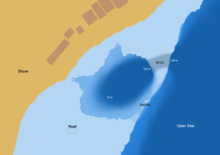Blue Hole (Red Sea)

Blue Hole is a diving location on east Sinai, a few kilometres north of Dahab, Egypt on the coast of the Red Sea.
The Blue Hole is a submarine sinkhole, around 94 m (300 feet) deep. There is a shallow opening around 6 m deep, known as "the saddle", opening out to the sea, and a 26 m long tunnel, known as "the arch", whose top is at a depth of 56 m (184 feet). The hole and the surrounding area have an abundance of coral and reef fish.
There is a local legend that the Blue Hole is cursed by the ghost of a girl who drowned herself there to escape from an arranged marriage.[1]
The Blue Hole is a hot spot for freediving because of the depth directly accessible from shore and the lack of current.
Dangers
The Blue Hole is dived almost every day by recreational divers. Local dive centres take divers who are qualified to dive to 30m to do the site known as El Bells or Bells to Blue Hole. The entry is further along from the Blue Hole at an entry called The Bells. At 26m at the bottom of the Bells is a mini arch that should not be confused with the arch in the Blue Hole itself. The dive is then a wall dive that finishes crossing the Blue Hole saddle at a depth of 7m. Recreational divers do not get to see the Blue Hole arch when doing the Bells to Blue Hole dive. The Egyptian Chamber For Diving & Watersports (CDWS) has a policeman stationed at the Blue Hole to ensure divers are diving with a certified guide to ensure safety procedures are followed.
However, the Blue Hole is notorious for the number of diving fatalities which have occurred in the past, earning it the sobriquet "World's Most Dangerous Dive Site" and the nickname "Diver's Cemetery". The site is signposted by a sign that says "Blue hole: Easy entry". Accidents happened as divers tried to find the tunnel through the reef (known as "The Arch") connecting the Blue Hole and open water at about 52 m (170.6 feet) depth. This is beyond most recreational diving limits and the effect of nitrogen narcosis is significant at this depth. Divers who missed the tunnel sometimes continued descending, hoping to find the tunnel farther down and became increasingly narcosed; furthermore, the rate of consumption of air by an open-circuit diver increases the deeper the diver descends.

The "Arch" is reportedly [1] extremely deceptive in several ways:
- It is difficult to detect because of the odd angle between the arch, open water, and the hole itself.
- Because of the dim lighting, most light entering from outside through the arch and lack of reference points, it appears shorter than it really is. Divers report that the Arch appears less than 10 m long but measurements have shown it is 26 m long from one end to the other.
- There is frequently a current flowing inward through the arch towards the Blue Hole, increasing the time it takes to swim through.
- The arch continues downward to the seabed which is beyond view and there is therefore no "reference" from below.
- In the very clear Red Sea water, the arch may seem to be nearer and smaller than it is.
- The diver's mind may be muddled by nitrogen narcosis.

Divers who resist the temptation of the Arch and remain within their training and limitations are in no more danger than on any other Red Sea dive site. However, the Arch has proved irresistible for many and thus the dive site is considered unsuitable for beginners and a potential trap for even experienced divers.

Diving through the arch requires suitable training and equipment, usually including a mixed-gas qualification from a technical diving training agency, technical diving equipment such as redundant gas supply, redundant large-capacity buoyancy control device and a breathing gas with reduced nitrogen content such as trimix.
The Egyptian authorities claim that 40 divers have died at this site since records began.
Yuri Lipski, an Israeli-Russian diving instructor, died at just over 300 feet underwater. At this depth, the body is subject to nitrogen narcosis, which can impair judgment and induce overconfidence, euphoria, hallucinations and confusion. Lipski had just one tank full of air — technical divers are better served by multiple tanks filled with trimix, a combination of oxygen, nitrogen, and helium that reduces narcosis.
A diver who retrieved Lipski's body at the request of his parents discovered that Lipski's helmet camera was still intact. The footage from the camera is available on YouTube, entitled "Fatal Diving Accident Caught On Tape". The footage shows a routine dive deteriorating into panicked thrashing as he becomes more disoriented, while clouds of kicked-up sand come into view as Lipski's breathing rate doubles. In the end, he removes the breathing apparatus from his mouth and the frame goes still.[1]
Coordinates: 28°34′19.99″N 34°32′14.55″E / 28.5722194°N 34.5373750°E
References
- 1 2 3 Monty Halls and the Divers' Graveyard, Channel 5 (UK) television, 9pm to 10pm, Monday 2 December 2013
External links
- Graphic: The Blue Hole in the Gulf of Aqaba. Diagram showing location of the arch.